Site pages
Current course
Participants
General
Module 1. History and types of greenhouse
Module 2.Function and features of greenhouse
Module 3.Scope and development of greenhouse techn...
Module 4.Location, planning and various components...
Module 5.Design criteria and calculations
Module 6. Construction materials and methods of co...
Module 7. Covering material and characteristics
Module 8. Solar heat transfer
Module 9. Solar fraction for greenhouse
Module 10. Steady state analysis of greenhouse
Module No. 11 Greenhouse Heating, Cooling, Sheddin...
Module 12. Carbon dioxide generation and monitorin...
Module 13. Instrumentation and & computerized ...
Module 14. Watering, fertilization, root substrate...
Module 15. Containers and benches
Module 16. Plant nutrition, Alternative cropping s...
Module 17. Plant tissue culture
Module 18. Chemical growth regulation
Module 19. Disease control, integrated pest manage...
Module 20: Post Production Quality and Handling
Module 21: Cost analysis of greenhouse Production
Module 22. Application of greenhouse & its rep...
Lesson 17 Heating Systems
17.1 INTRODUCTION
A Greenhouse is developed with a motto of getting optimum crop production or maximum profit. This includes an environment for work efficiency as well as for crop growth. There are many methods and equipment which are used for controlling or maintaining desired temperature and other environmental conditions
inside a greenhouse. While selecting a heating system one needs to consider types of plants produced, level of quality of production strived for, types of greenhouses used and management procedures followed.
17.2 HEATING OF GREENHOUSE
A good heating system is one of the most important steps to successful plant production. Any heating system that provides uniform temperature control without releasing material harmful to the plants is acceptable. Suitable energy sources include natural gas, LP gas, fuel oil, wood and electricity. The cost and availability of these sources will vary somewhat from one area to another. Convenience, investment and operating costs are all further considerations. Savings in labour could justify a more expensive heating system with automatic controls. Greenhouse heater requirements depend upon the amount of heat loss from the structure. Heat loss from a greenhouse usually occurs by all three modes of heat transfer: conduction, convection and radiation. Usually many types of heat exchange occur simultaneously. The heat demand for a greenhouse is normally calculated by combining all three losses as a coefficient in a heat loss equation.
17.2.1 Factors affecting heat loss
Heat loss by air infiltration depends on the age, condition and type of greenhouse. Older greenhouses or those in poor condition generally have cracks around doors or holes in covering material through which large amounts of cold air may enter. Greenhouses covered with large sheets of glazing materials, large sheets of fibre glass, or a single or double layer of rigid or flexible plastic have less infiltration (Figure17.2.1).

Fig 17.2.1 Energy loss due to infiltration
(Source: John Worley et al. 2011)
The greenhouse ventilation system also has a large effect on infiltration. Inlet and outlet fan shutters often allow a large air exchange if they do not close tightly due to poor design, dirt, damage or lack of lubrication. Window vents seal better than inlet shutters, but even they require maintenance to ensure a tight seal when closed. Solar radiation enters a greenhouse and is absorbed by plants, soil and greenhouse fixtures. The warm objects then re-radiate this energy outward. The amount of radiant heat loss depends on the type of glazing, ambient temperature and amount of cloud cover. Rigid plastic and glass materials exhibit the “greenhouse effect” because they allow less than 4 percent of the thermal radiation to pass back through to the outside.
17.2.2 Heat loss calculation
Heat loss by conduction may be estimated with the following equation:
Q = A (Ti - To)/R
Where,
Q = Heat loss, BTU/hr
A = Area of greenhouse surface, sq ft
R = Resistance to heat flow (a characteristic of the material)
(Ti - To) = Air temperature differences between inside and outside
Table17.2.1 lists different materials commonly used in greenhouse construction and their associated R values. Table 17.2.1 also lists overall R values for various construction assemblies. Note that high R values indicate less heat flow. Building materials that absorb moisture will conduct heat once they are wet. Use vapour barriers to protect materials that are permeable to water vapour. Heat is also lost to the ground underneath and beside a greenhouse. The perimeter heat loss may be added to other losses using Table 17.2.1 and the equation:
Q = PL (Ti - To)
P = Perimeter heat loss coefficient, BTU/ft ºF hr
L = Distance around perimeter
Add infiltration heat losses to the conduction heat losses. The equation for infiltration heat transfer follows:
Q = 0.02 V C (Ti - To)
V = Greenhouse volume, cu ft
C = Number of air exchanges per hour
Table 17.2.2 lists estimates of air exchanges through types of greenhouses. The number of air exchanges per hour will vary depending on the type and condition of the greenhouse and the amount of wind.
Table 17.2.1 Heat flow through various construction materials and assemblies.
|
Materials |
R value |
|
Glass fiber board, 1" |
4.0 |
|
Expanded polystyrene, 1", cut surfaces |
4.0 |
|
Expanded polystyrene, 1", smooth skin surface |
5.0 |
|
Expanded polystyrene, moulded beads, 1" |
3.6 |
|
Expanded polyurethane, 1" |
6.2 |
|
Vermiculite, 1" |
2.2 |
|
Glass fibre blanket, 3-3.5" |
11.0 |
|
Glass fibre blanket, 5.0-6.5" |
19.0 |
|
Wall material |
|
|
Concrete block, 8" |
2.0* |
|
Plywood, ½” |
1.43* |
|
Concrete, poured, 6" |
1.25* |
|
Concrete block or plywood, plus 1" foamed urethane |
7.69* |
|
or plus 1" polystyrene |
5.0* |
|
Greenhouse with thin thermal curtains |
1.42-3.33* |
|
Construction assemblies material |
|
|
Roof and wall coverings |
|
|
Glass, single layer |
0.91* |
|
Glass, double layer, ¼” space |
2.00* |
|
Polyethylene or other film, single layer |
0.83* |
|
Polyethylene or other film, double layer separated |
1.43* |
|
Polyethylene film, double layer, separated, over glass |
2.00* |
|
Fiberglass reinforced pane |
0.83* |
|
Double acrylic or polycarbonate |
2.00* |
|
Perimeter |
BTU/linear ft.°F hr |
|
Uninsulated |
0.8 |
|
Insulated |
0.4 |
* Includes effects of surface coefficients
Table 17.2.2 Natural Air Exchanges for Greenhouses
|
Construction System |
Air Exchanges per Hour1 |
|
New Construction, glass or fiberglass |
0.75 to 1 |
|
New Construction, double layer plastic film |
0.5 to 1.0 |
|
Old Construction glass, good maintenance |
1 to 2 |
|
Old Construction glass, poor condition |
2 to 4 |
1 Low wind or protection from wind reduces the air exchange rate.
Minimum Design Temperatures
A good outside temperature to use in heater design calculations (to select heater size) can be found by subtracting 15°F from the average daily minimum January temperature. Another requirement the heater must meet is to provide enough heat to prevent plants from freezing during periods of extremely low temperatures.
17.2.3 Other heating system design considerations
Plastic greenhouses often have a humidity build-up within the enclosure since almost no cracks or openings exist as in a glass house. High humidity can lead to increased occurrence of leaf and flower diseases. A forced air heating system helps mix the air within the house and helps prevent temperature variation within the house. In fact, it is desirable to have fans along the walls to circulate and mix the warm air with the cooler air near the surface. They can be operated continuously during cold periods even if the heater is not on.
Duct systems to evenly distribute the heated air from the forced warm air furnace are desirable. Two or more small heating units are preferable to one larger unit, since two units offer more protection if one unit malfunctions. A warning device is good insurance should the heating system malfunction or if a power failure occurs. Some greenhouse operators prefer to have a battery powered alarm system to warn them if the temperature gets out of the acceptable range.
17.3 HEATING SYSTEM
17.3.1 Unit Space Heater
Unit space heaters, either floor mounted or supported, are normally fuelled with natural or bottled gas or fuel oil and use fans for heat distribution. This system requires a relatively moderate capital investment, is easy to install, and provides for easy expansion of facilities. If unit air heaters are used they should be spaced and directed to blanket the entire area with heated air.
There are two main types of unit heaters that are used for space heating in greenhouses: vented and unvented. The traditional vented gas fired unit heater transfers heat from combustion gases outside the greenhouse through a flue pipe. An unvented unit heater burns the gas and exhausts all combustion gases directly into the greenhouse, so virtually all the heat from the fuel is used to heat the air.
There are four types of vented unit heaters; gravity vented, power vented, separated combustion and high efficiency condensing heaters.
17.3.1.1 Gravity vented unit heaters
Gravity vented unit heaters rely on thermal buoyancy and draw from wind blowing past the vent pipe to exhaust the flue gases. These heaters use inside air for combustion which accounts for 2% of the efficiency loss and some heaters use continuous pilot lights, which consume a small amount of additional energy. Thermal efficiency of gravity vented unit heater is 80%.
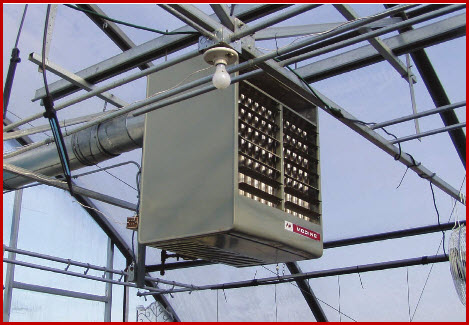
Fig 17.3.1 Gravity vented unit heaters
(Source: Scott Sanford, 2011)
17.3.1.2 Power vented unit heaters
A power vented unit heater has small blower that meters the correct amount of air for combustion and exhaust the flue gases. The blower operates only when the heater is firing. This type of unit heater uses a smaller exhaust pipe that can be run horizontally through the wall of the greenhouse reducing installation costs and acting like a vent damper to minimize thermal buoyancy losses. Gas fired power vented heaters often use an intermittent or electronic pilot, which reduces flameouts and pilot gas use. The seasonal efficiency of a power vented unit heater is typically about 78% with thermal efficiency of 80%.

Fig 17.3.2 Power vented unit heaters
(Source: www.modinehvac.com )
17.3.1.3 Separated combustion unit heaters
Separated combustion heater is designed for heating areas that have negative pressure or high humidity, dusty or corrosive environments. These heaters use a power vented exhaust and have a separate air intake duct for combustion air. Modern plastic greenhouses are tightly constructed with fewer seams than glass greenhouses and thus have low infiltration rates, it is possible during times of peak heating for many types of unit heaters to use enough oxygen in the greenhouse to cause poor combustion or to cause flue gases to be drawn into the greenhouse through the flue pipe. Back drafts of flue gases can be a problem if greenhouse is located in windy area or if exhaust fans and heaters are inadvertently used at the same time. Thermal efficiency of these heaters is 80%.
17.3.1.4 High efficiency condensing heater
These heaters condense some of the moisture out of flue gas to squeeze out more energy. This technology has been around for many years and is used in most residential furnaces sold today. High efficiency condensing heaters use a power vented exhaust and a separate air intake, so heated greenhouse air is not used for combustion and they require a drain or other way to dispose of the acidic condensate. Both the thermal and seasonal efficiencies are typically about 93%. High efficiency condensing heaters are more expensive than other types but they provide more heated air per unit of fuel.
17.3.1.5 Portable unit heaters
Portable unit heaters are often used for temporary or emergency heating and operate on kerosene heating oil or LP gas. These unvented units are not suited for use in enclosed structures because they do not have air intake venting. If using portable units for emergency or temporary greenhouse heating, use only LP gas fired units and open a vent or prop open a door to replace the oxygen burned by the heater.
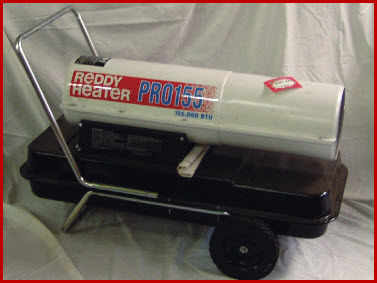
Fig 17.3.3 Portable unit heaters
(Source: Scott Sanford, 2011)
17.3.2 Hot water system
Hot water systems utilizing piping that can be perimeter, under benches, or overhead fan forced unit heaters can be used. These require a boiler, valves, and other necessary controls. However, a hot water system is simpler to install and normally requires less maintenance than a steam system. There are slower heating and cooling of pipes, but temperatures are normally more uniform. Hot water systems are mainly used in smaller ranges.
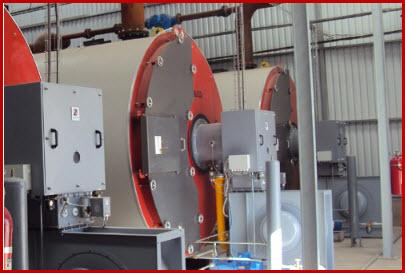
Fig 17.3.4 Hot water system
(Source: http://blog.maripositas.org)
17.3.3 Steam heating system
A steam heating system needs a boiler, valves, traps and other controls depending upon the size and type of boiler used. Steam provides rapid heating and cooling of the steam lines and usually pipe length needed is less. Lines may be smooth or finned, and about l/3 of the heat should be overhead and about 2/3 along the side walls. Lines can also be arranged under benches or with overhead fan-forced unit heaters. A steam system also allows the use of steam for soil pasteurization. A steam system requires a high initial investment; however, it has a long life expectancy. Steam heating systems are most often used in large ranges as steam can be transported long distances efficiently.
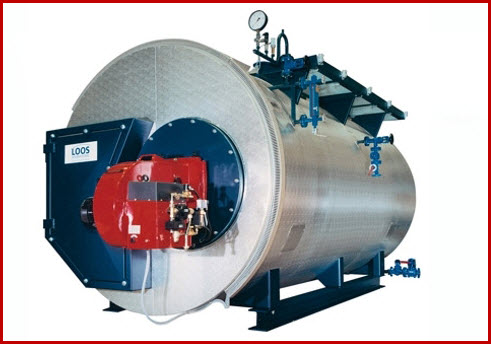
Fig 17.3.5 steam heater
(Source: http://blog.maripositas.org)
The boiler has to distribute the steam or hot water into the greenhouse there are various ways of doing this as shown below:
Pipe rail heating distribution

(Source: http://blog.maripositas.org)
Hoist Heating distribution

(Source: http://blog.maripositas.org)
Under Bench Heat Distribution

(Source: http://blog.maripositas.org)
In Floor Heat Distribution

(Source: http://blog.maripositas.org)
Overhead Heat Distribution
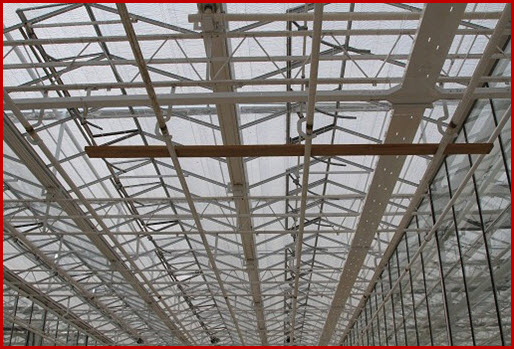
(Source: http://blog.maripositas.org)
Perimeter Heat Distribution

(Source: http://blog.maripositas.org)
17.3.4 Unit radiant heaters
Radiant heater, as opposed to warm air systems (such as a forced air unit heaters), delivers the source of heat to the floor level, not the ceiling. Radiant energy is the oldest form of heating used to provide comfort and is the basis for all heating systems. Radiant energy is totally pure radiation and is absorbed by an object without physical contact with the heat source or by heating the surrounding air, as is the case with convective, forced air systems. Radiant heaters are the most efficient and effective method in which to deliver "heat" under the diverse conditions present in warehouses, garages, storerooms as well as the largest facilities imaginable. Hot gases are moved through the radiant tube either by vacuum (negative) or power (positive) pressure. The radiant energy produced is then directed downward by the reflectors positioned above the radiant tubes. The floor is typically the largest mass within any building. Thus the floor becomes the primary source of heat. A gas fired radiant heating system emulates the suns radiant output. Like the sun, the radiant tube emits Radiant energy in all directions. Convection loses from a radiant tube which is not covered by a reflector are great. Reflectors positioned above the radiant tube direct the radiant energy towards the floor area. The radiant energy is converted into heat when absorbed by objects in its path. The radiant energy is absorbed by the building's heat sinks, i.e. concrete floors, machinery, fixtures, etc. This heat sink is what in turn re-radiates energy for the "warmth" that is felt in the surrounding air. Because stratification of air (difference between floor temperature and ceiling temperature) is significantly lower than conventional hot, forced air systems, the structure heat loss is greatly reduced resulting in large savings in heating dollars.

Fig 17.3.6 Radiant heaters
(Source: www.radiantheater.net )
17.3.5 Solar Heating system
Solar heating is often used as a partial or total alternative to fossil fuel heating systems. Few solar heating systems exist in greenhouses today. The general components of solar heating system (Fig. 17.3.7) are collector, heat storage facility, exchange to transfer the solar derived heat to the greenhouse air, backup heater to take over when solar heating does not suffice and set of controls.
Various solar heat collectors are in existence, but the flat plate collector has received greatest attention. This consists of a flat black plate (rigid plastic, film plastic, sheet metal, or board) for absorbing solar energy. The plate is covered on the sun side by two or more transparent glass or plastic layers and on the backside by insulation. The enclosing layers serve to hold the collected heat within the collector. Water or air is passed through the copper tubes placed over the black plate and absorb the entrapped heat and carry it to the storage facility. A greenhouse itself can be considered as a solar collector. Some of its collected heat is stored in the soil, plants, greenhouse frame, floor, and so on. The remaining heat is excessive for plant growth and is therefore vented to the outside. The excess vented heat could just as well be directed to a rock bed for storage and subsequent use during a period of heating. Collection of heat by flat-plate collector is most efficient when the collector is positioned perpendicular to the sun at solar noon. Based on the locations, the heat derived can provide 20 to 50% of the heat requirement.
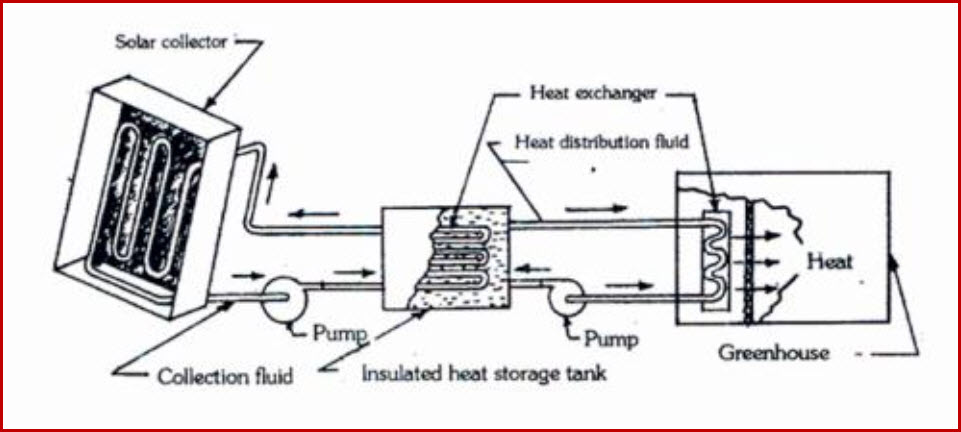
Fig 17.3.7 Solar heating system used for greenhouse heating
(Source: www.tnau.ac.in)
17.4 FACTORS TO CONSIDER WHILE SELECTING GREENHOUSE HEATING SYSTEM
Before determining the type of a system to use, it is necessary to calculate the amount of heat that will be required. Remember this should be based on the most adverse conditions that you reasonably expect to encounter.
The minimum inside temperature depends on the type of plants to be grown. Decide whether you just want to save the plants from the severe injury or if you want normal or near normal growth to continue. Then determine the temperature needed to achieve your objective, subtracts expected minimum adverse temperature for your location and obtain the differential in °F or which you need to be prepared.
An easy and fairly accurate method for estimating the amount of heat required can be obtained by multiplying the surface area of the greenhouse by the maximum temperature difference to be maintained, and this product times a heat transmission factor that depends on the covering of the greenhouse and is also influenced by quality of construction. A factor of 1.0 to 1.2 is used if the house is covered by a single layer of polyethylene film (PE) or rigid plastic. 1.0 would assume a well built, tight greenhouse, while 1.2 would assume a little less quality construction and more air leakage. The same analogy will be true for the transmission factors used for other materials.
Also, wind velocity affects the transmission factor; the higher the wind velocity, the greater the heat loss. Use a factor of 0.75 to 0, if the house is covered with a double layer of PE film with an air space of atleast 3/4² but not more than 4². Use a factor between 1.1 to 1.4, if the greenhouse is glass glazed. Add 10 percent to the values obtained if the house is located in a windy location and there are many leaks for air infiltration. If the house were very highly constructed and fairly large panels were used and, if the house were protected by a wind brake of some kind then you can use a lower heat transmission factor of about 1.0. Then calculate the heating input required and use its value to determine the pipe length in steam and hot water systems or the size of the unit heaters. If a central boiler is used, add at least 25 percent to determine boiler size to allow for heat losses in the distribution system.
Another factor to consider is the efficiency of the heating unit. Most manufacturers of heating equipment show both input and output BTU/hr. Calculations on equipment size must be based on output capacity.
In conclusion, successful heating of greenhouses is dependent upon correct sizing and installation of the heating system, proper controls and methods of obtaining uniform heat distribution. A type of greenhouse construction, crops to be grown and temperature levels to be maintained are all important factors to consider in the selection and design of any greenhouse heating system.
Heating system should allow for easy expansion of the range in the future, and the system should have sufficient capacity to offset the heat loss from the greenhouse under most severe conditions. Normally design for temperatures slightly above minimum 15 to 25 year lows as shown by local weather records.
Provide an adequate system of automatic controls. The most important control in most heating systems is the thermostat, which is used to control the operation of the heating system. For this reason, the thermostat should be placed at plant level, and shielded from direct rays of the sun, and it should sense “line air.” Thermostats for greenhouses should be accurate to within at least 2-3 °F. It is not enough to have good control over the heating system. An operator must know what degree of temperature control is necessary for the type of plants being produced.
If possible, select a heating system that will allow you to convert from one fuel source to another.
REFERENCES
Buffington, D.E et.al (2013): Heating Greenhouses
Scott Sanford (2011): Greenhouse Unit Heaters, Types, Placements & Efficiency (www.edis.ifis.ufl.edu/ae015 )
www.tnau.ac.in : Greenhouses and Post- Harvest Technology
John Worley et al.(2011). “ Greenhouse Heating, Cooling and ventilation”, Bulletin 796, The University of Georgia and Ft. Valley State University, the U.S. Department of Agriculture and counties of the state cooperating.